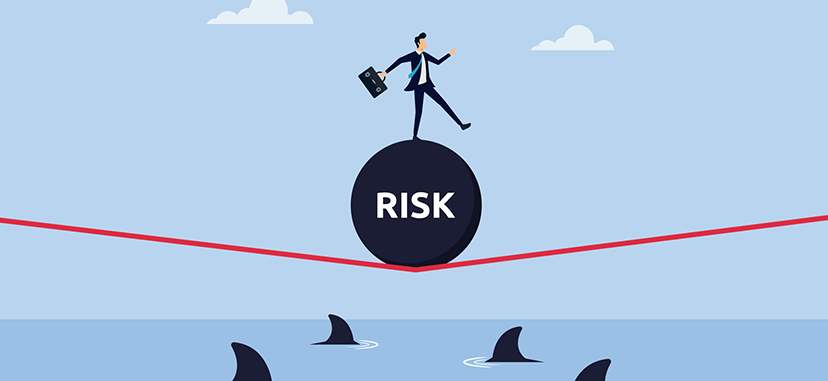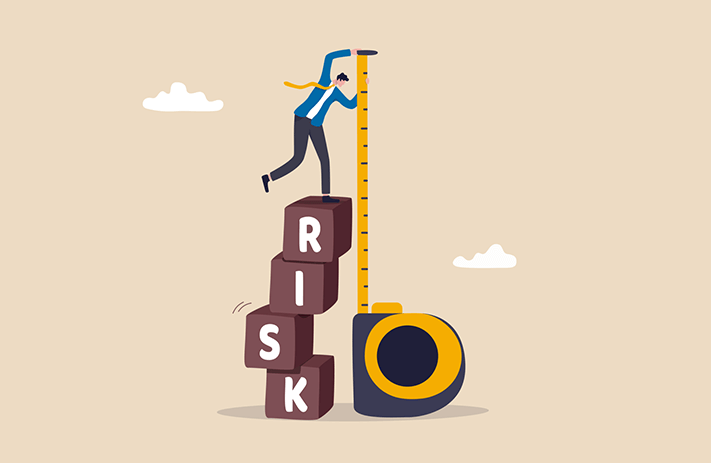
Click the button to start reading
Managing Risks in Business: A Guide for Entrepreneurs
Projects, by their very nature, involve a degree of uncertainty and inherent risks. Every business needs appropriate risk management in place to make sure projects not only meet their objectives but are also completed on time and within budget.
Risk management empowers project managers to spot potential issues and roadblocks ahead of time, giving them a chance to make well-informed decisions and take the necessary steps to reduce or eliminate those risks.
With a proper approach to risk management strategies in place, organizations can better anticipate, plan for, and respond to various challenges, ensuring that their projects have a higher probability of success.
In the context of project management, risk management helps to ensure that resources are used efficiently, stakeholder expectations are managed, and the risk of project failure is kept to a minimum.
This article will serve as your guide to risk management in business and help you and your team devise your own risk management tolerance. Keep reading for examples of risk management in business and best practices for creating your strategy.

What is Risk Management in Business?
Risk management is about proactively identifying, evaluating, and addressing potential threats that could impact a business’s ability to reach its goals.
It’s an ongoing process that helps protect a company’s assets, reputation, and financial health while seizing growth opportunities.
Spotting risks:
The first step is to identify possible risks by examining internal and external factors, such as market conditions, regulations, or tech advancements. Tools like SWOT or PESTLE analysis can help with this.
- SWOT Analysis: stands for Strengths, Weaknesses, Opportunities, and Threats
- Strengths: Positive attributes, resources, and capabilities within the organization
- Weaknesses: Internal limitations, vulnerabilities, and areas for improvement
- Opportunities: Favorable situations or trends in the external environment that the organization can leverage
- Threats: External challenges, risks, or obstacles that could negatively impact the organization
- PESTLE Analysis: stands for Political, Economic, Sociocultural, Technological, Legal, and Environmental factors
- Political: Government policies, regulations, political stability, and trade policies
- Economic: Economic growth, interest rates, exchange rates, inflation, and unemployment
- Sociocultural: Demographics, social trends, consumer attitudes, and cultural factors
- Technological: Technological advancements, innovation, automation, and digitalization
- Legal: Laws, regulations, and legal requirements affecting the organization’s operations
- Environmental: Ecological and environmental aspects, such as climate change, sustainability, and resource scarcity
Assessing risks:
Once potential risks have been identified, they need to be assessed in terms of their probability of occurrence and potential impact on the organization. This can be done using qualitative or quantitative methods, such as risk matrices, risk scoring, and probability-impact assessments.
Developing strategies:
After assessing and prioritizing risks, organizations must develop appropriate risk response strategies to mitigate, transfer, accept, or avoid the identified risks. The chosen method will depend on factors like the organization’s risk appetite, the cost of implementing the strategy, and the potential benefits of addressing the risk.
We’ll be discussing methods for developing strategies for risk management in business more in another section, but first, we need to look at what kind of risks exist for businesses, so keep reading for more.

Understanding Business Risks That Could Affect Operations
Business risk refers to the potential threats, uncertainties, and challenges that could negatively impact an organization’s ability to achieve its goals and objectives.
These risks can arise from various internal and external factors and can manifest in different forms, such as financial losses, operational disruptions, or reputational damage.
Let’s take a look at the types of risks that businesses may be exposed to:
- Strategic risks: These are risks associated with an organization’s overall direction and decisions. Strategic risks can result from poor planning, inadequate market research, or changes in the competitive landscape.
- Compliance risks: These risks arise from the failure to adhere to laws, regulations, and industry standards. Non-compliance can lead to fines, penalties, or legal action against the organization.
- Operational risks: These risks are associated with the day-to-day operations of an organization, such as equipment failures, human errors, or supply chain disruptions. Operational risks can impact productivity, efficiency, and the overall performance of a business.
- Financial risks: Financial risks are related to the organization’s financial stability, including factors like currency fluctuations, interest rate changes, credit risks, or liquidity issues. These risks can affect a company’s profitability and financial health.
- Reputational risks: Reputational risks involve threats to an organization’s reputation or public image. This can result from negative publicity, customer dissatisfaction, or unethical practices. Damage to a company’s reputation can lead to loss of customers, partners, or investors.
Identifying potential risks in project management
In the context of project management, risks can arise from various sources, such as scope changes, resource constraints, technical challenges, or stakeholder expectations.
To identify potential risks, project managers should:
- Collaborate with stakeholders to gather their insights and concerns
- Review project documents, such as project plans, schedules, and budgets, to identify potential problem areas
- Conduct risk assessment workshops to encourage team members to share their perspectives on potential risks
- Monitor project progress regularly and proactively identify new risks as they emerge
- Use risk identification tools and techniques, like SWOT or PESTLE analysis, to examine both internal and external factors that could impact the project
In a perfect world, everything would go to plan every time, but that’s a far cry from reality. Problems will happen, sometimes entirely out of your control, but the good news is that each issue that arises is a learning opportunity.
And each learning opportunity can inform your risk management strategies.

Developing a Risk Management Plan
Developing a risk management plan is crucial to any successful project, as it ensures that potential risks are proactively identified, assessed, and addressed.
A well-structured plan enables organizations to navigate uncertainties, make informed decisions, and minimize the likelihood of project failure.
Let’s take a look at the steps involved with creating your plan for risk management for business:
Key components of a risk management plan
- Risk context: A comprehensive description of the project’s scope, objectives, stakeholders, and risk appetite, as well as any external factors that could influence risk exposure. This provides a clear understanding of the project environment and helps ensure that risks are assessed and addressed in alignment with the organization’s overall strategy and priorities.
- Risk identification: A thorough list of potential risks that could impact the project, categorized by their sources (e.g., operational, financial, strategic, etc.) and accompanied by a brief description of each risk. This helps create awareness of potential threats and enables the project team to effectively prepare for and address these risks.
- Risk analysis: A detailed assessment of the likelihood and potential impact of each identified risk, taking into consideration factors like the project’s complexity, available resources, and the organization’s risk tolerance. This process allows project managers to prioritize risks and allocate resources accordingly, focusing on the most significant threats to the project’s success.
- Risk evaluation: A systematic prioritization of risks based on their likelihood, impact, and the organization’s risk tolerance, resulting in a ranked list that helps guide decision-making and resource allocation. This step ensures that the project team focuses on the most critical risks while maintaining a balanced approach to risk management.
- Risk treatment: A set of well-defined risk response strategies and action plans for addressing significant risks, including specific actions, resources, timelines, and responsibilities for each risk. This component also involves contingency planning, which outlines alternative courses of action.
- Risk monitoring and review: A set of processes and tools for regularly tracking risks, evaluating the effectiveness of risk response strategies, and updating the risk management plan as needed. This includes performance indicators, risk audits, and lessons learned reviews to ensure continuous improvement and adaptation to changing circumstances.
A well-prepared risk management plan helps the teams involved with decision-making, improving communication among team members and stakeholders and promoting a culture of risk awareness and proactive problem-solving.

Strategies for Managing Risks in Business
Effectively managing risks involves employing a range of strategies tailored to the specific threats and challenges that an organization faces.
In this section, we’ll explore various strategies for managing risks. A mixture of these methods can inform your tolerance risk, allowing your teams to operate more freely while protecting the business.
Engaging independent experts
Hiring external experts to objectively assess a project’s risks can be a valuable strategy. Independent experts can offer specialized knowledge, experience, and insights that may not be available within the organization.
They can help identify potential risks, recommend best practices, and provide guidance on risk mitigation strategies.
Example:
- Large-scale infrastructure project hires independent experts to assess geological, environmental, and regulatory risks
- Experts provide recommendations to proactively address potential issues, ensuring project completion on time and within budget
Obtaining insurance
Insurance is a common risk management strategy to transfer certain risks to a third party. Organizations can protect themselves against potential financial losses from natural disasters, accidents, or legal claims by obtaining insurance coverage.
Insurance can help ensure business continuity and financial stability in the face of unforeseen circumstances.
Example:
- Manufacturing facility faces risks related to equipment failure and supply chain disruption
- Comprehensive insurance coverage protects against financial losses resulting from equipment breakdowns, natural disasters, or other events
Establishing limited liability
Creating a limited liability entity, such as a corporation or a limited liability company (LLC), can effectively manage risks by separating an individual’s personal assets from the business’s liabilities.
This legal structure can protect owners and investors from being personally liable for the company’s debts and obligations, thus limiting their financial exposure in case of a lawsuit or bankruptcy.
Example:
- A group of entrepreneurs decides to launch a new business venture in the retail sector. The potential risks associated with the business include lawsuits, debts, and financial obligations
- The entrepreneurs establish a limited liability company (LLC) for the new venture to protect their personal assets and limit their financial exposure. By creating the LLC, the entrepreneurs’ personal assets are protected from any debts or legal claims related to the business, effectively managing their risk exposure
Diversification
Diversification is a risk management strategy that involves spreading investments, resources, or activities across a range of areas to reduce the potential impact of any single risk.
This can be applied to various aspects of a business, such as product offerings, supply chain partners, or revenue streams. By diversifying, organizations can minimize the potential negative effects of a single event or risk on their overall performance.
Example:
- Technology company primarily focused on a single product line recognizes risks associated with overreliance on one revenue stream
- The company diversifies its product portfolio to spread risk and reduce the impact of market changes or product failures on its overall performance
Risk avoidance
In some cases, the best risk management strategy may be to avoid the risk entirely. This approach involves choosing not to engage in an activity or pursue a project that carries significant risks.
Risk avoidance may be appropriate when the potential negative consequences outweigh the potential benefits or when an organization lacks the resources or expertise to manage the risk effectively.
Example:
- A healthcare organization identifies a high-risk project with potentially harmful consequences that outweigh the potential benefits
- Decision made not to pursue the project, effectively avoiding significant risks
Establishing contingency plans
Developing contingency plans is a proactive approach to managing risks by preparing alternative courses of action in case the primary risk response strategies fail, or new threats emerge.
Contingency planning involves:
- Identifying potential scenarios
- Outlining the steps to respond to new threats
- Assigning responsibilities to team members
These plans can help organizations respond quickly and effectively to unexpected events, minimizing disruptions and maintaining project momentum.
Example:
- An agriculture company identifies potential scenarios where primary risk response strategies may fail, or new risks could emerge
- Contingency plans developed, outlining alternative courses of action and assigning responsibilities to team members
By employing a combination of these risk management strategies, organizations can better navigate uncertainties, protect their assets, and ensure the success of their projects.

Best Practices for Risk Management
Adopting best practices in risk management helps organizations create a systematic approach to identifying, assessing, and mitigating risks throughout the project lifecycle. Here are some key best practices to consider when implementing a risk management plan:
Develop a risk management culture
- Encourage a culture of risk awareness and proactive risk management within the organization
- Foster open communication and collaboration among team members, promoting the sharing of information, concerns, and insights related to potential risks
Establish a clear risk management process
- Implement a well-defined, systematic risk management process that aligns with the organization’s objectives, priorities, and risk tolerance
- Ensure that the risk management process is consistently applied across all projects and activities
Involve stakeholders in the risk management process
- Engage stakeholders, including team members, clients, and partners, in the risk identification, assessment, and mitigation process
- Seek diverse perspectives to gain a comprehensive understanding of potential risks and opportunities
Continuously update and refine the risk management plan
- Regularly review and update the risk management plan to reflect changes in the project environment, progress, and emerging risks
- Learn from past experiences and apply lessons learned to improve the effectiveness of risk management strategies
Implement effective risk monitoring and control
- Establish clear risk monitoring and control mechanisms, including performance indicators, risk audits, and progress reporting
- Regularly evaluate the effectiveness of risk response strategies and make adjustments as needed to ensure that risks are effectively managed throughout the project lifecycle
Integrate risk management with project management processes
- Incorporate risk management considerations into all aspects of project management, such as planning, resource allocation, and performance monitoring
- Ensure that project managers and team members are equipped with the necessary tools, knowledge, and support to effectively manage risks
By following these best practices, organizations can create a robust risk management framework that minimizes the likelihood of project failure, maximizes the efficient use of resources, and supports achieving project objectives.
Conclusion
Eliminating all risks is, unfortunately, a daydream that’s unlikely to happen for any business, no matter the industry.
Being prepared with a strategy for risk management in business is the only way to get out in front of potential issues. With the situation constantly changing, including external factors like consumer demand, political concerns, and supplier issues, it is essential to stay adaptive and vigilant.
Embracing a proactive approach to risk management helps entrepreneurs and organizations to identify, assess, and address risks before they escalate into significant problems.
















